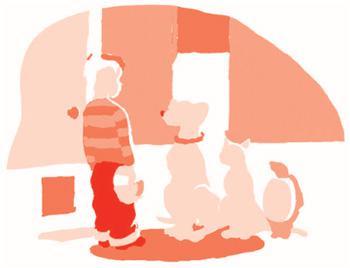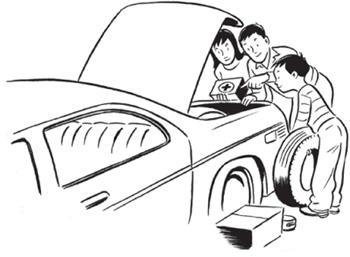Just in Case (28 page)

FEEDING KIDS IN A CRISIS
C
HILDREN ARE USUALLY
far less accepting of unfamiliar foods than adults, which is why getting them accustomed to eating stored food on a regular basis is so important. If your child is used to a steady diet of Sugar-Frosted Gummy Tidbits and a glass of sweetened juice for breakfast every morning, getting her to welcome oatmeal with raisins and brown sugar is going to be a challenge. Start teaching your children the value of a healthy diet now. Let your child go “shopping” with you in your pantry. You can set up a store and let her choose some foods to put in her own grocery sack and check them out with you as the cashier. Encourage her to help with the food preparation and play waiter. Not only might this help your kids be more willing to try something new, but they will be gaining valuable, real-life skills that may be of use in a crisis.
SKILLS BUILD CONFIDENCE
H
AVE YOUR CHILDREN
participate in groups such as 4-H, Scouts, and Camp Fire, where they can learn valuable skills such as cooking, sewing, gardening, and small engine repair. As soon as possible, children should learn basic first aid and CPR. They should also learn to swim. Taking classes such as self-defense together can be an enjoyable experience for both of you, and a confidence builder.
Every family should run routine fire drills. Make sure your children know what to do if the smoke or CO
g
detector goes off and how to evacuate from all areas of your home. Teach young children their name, address, and phone number and how to dial 911. Teach older kids how to drive as soon as they are of legal age, at least well enough to move the family car to provide room for emergency vehicles.
KEEPING KIDS HAPPY
K
EEPING CHILDREN OCCUPIED
when the lights go out can be a challenge, especially if they are used to being plugged in or transported to activities in order to be entertained. It helps if they’ve had some practice in lowtech entertainment, so you might consider turning off computers and the television one night a week and playing games or doing fun projects together as a family.
Crayons or markers and paper, Play-Doh, and other craft supplies are good to have on hand. Jigsaw puzzles and board games that involve the whole family, like Clue, Monopoly, and Yahtzee, can entertain for hours. Dolls, blocks, and toy cars should be in every house with kids. And start amassing a library. Books such as the
Little House on the Prairie
series, the Boxcar Children stories,
Hatchet, My Side of the Mountain,
and others that depict children using ingenuity to survive adversity are good choices.
Be prepared to teach your child at home in the event you’re shut in for more than a couple of days. Have some workbooks tucked away to pull out when the time is right.
Above all, try to establish and stick to a regular routine with your kids. Your children will be most comfortable if a crisis disrupts their daily routine as little as possible.
WHEN IT’S OVER
A
FTER ANY CRISIS,
keep a close eye on children for signs of stress. A change in eating, sleeping, or toilet habits might signal that your child is suffering from a stress reaction. This happened a lot after 9/11; even preschoolers were talking about the terrorists. In my opinion, today’s kids are exposed to too much unnecessary information about everything from child predators to terrorism. It is our job to protect children from information they cannot process. Being prepared should not translate into scaring our children with tales of possible calamities. Rather, it should be another opportunity for children to acquire age-appropriate information and skills that will enable them to take part in a family’s goal of self-reliance.
Capable children are confident children. Confident children will come through a crisis with their sense of security intact, gratified by the contributions they can make toward their family’s wellbeing.
CHAPTER 7 PETS

Pets are just as vulnerable to the stress of a crisis as people are and deserve as much consideration in the building of a family preparedness plan. In general, cats, birds, and rodents are more forgiving of changes in routine than dogs are. They also are better able to fend for themselves if you need to leave them alone for a day or two, assuming you leave them with enough food and water and adequate shelter. However, no domestic animal can fend for itself indefinitely. If you make the commitment to acquire a pet, you must have a plan in place to care for it in a crisis.
PREPARING YOUR HOME
I
F YOU ARE
able to remain in your home during a crisis, preparedness is a simple matter of storing a supply of food and ensuring your access to water. Emergency situations are not the time to introduce any animal to a new food. If your dog is used to dry food, a quick switch to table scraps or canned food is likely to seriously disrupt his system. So store the same type of food your pet is used to eating. The amount of food you will need to store will depend on the size of the animal and the length of time you’ve decided to prepare for. Like people food, pet food needs to be protected from humidity, heat, and pests such as insects and rodents. Galvanized metal garbage cans with secure lids are a good choice for storing quantities of dry food.
If you have a dog, you’ll also need a plan for exercising him, so that neither you nor he are made crazy by his pent-up energy. You might consider practicing some indoor exercise games with your dog now, before any kind of crisis, so that you both are used to the routine.
You will need to make provisions for your animal’s wastes in the event that you are not able to bring him outside. Again, with dogs, practicing now will make the routine easier in a time of crisis. Cats will need kitty litter boxes and plastic bags for disposing of soiled litter.
PREPARING FOR EVACUATION
I
F YOU MUST
leave home, more detailed systems must be in place. You must have a copy of your pet’s immunizations with you; keep it with your other vital records. You will also need food, feeding and watering equipment such as bowls, and plastic bags for cleaning up waste. If you have a dog, you will also need a crate, leash, collar with tags, and a muzzle.
Keep with your evacuation kit (see page 93) a large, full-color picture of your pet, in case your pet becomes lost. You might also consider having an electronic identification marker surgically implanted in your pet; your vet will have more information about this technology.
Finding a place to stay with your pet can be a hassle if you haven’t done your homework ahead of time. If the crisis has affected just your home or neighborhood, as might be the case in a fire or localized flooding, an animal shelter or kennel might be a good option. Some hotels accept pets; check the Web site
www.petswelcome.com
for a list of hotels in your area that are pet friendly. You’ll want to check out all the local options so that when the time comes you’ll feel comfortable bringing your pet to your chosen shelter. Since finding shelter for a pet is so unpredictable, your best bet may be to make arrangements for a friend who lives out of the danger zone to care for your pet if necessary.
RETURNING HOME
W
HEN YOU ARE
able to return home with your pet, give him some time to settle in. Major storms and floods can leave dangerous debris behind, so be alert for hazards like downed power lines, broken glass, rodents, and animal carcasses.
Dogs in particular may be uneasy returning home, especially if their surroundings look or smell different. Allow your pet some leash time to explore and get reacquainted with the territory. Be alert for changes in his behavior. Even the most even-tempered dog may become defensive or aggressive in a chaotic and unfamiliar environment.
If you have lost a pet during a crisis, after you return home, contact your local animal control office as soon as possible. It will have information on where lost pets can be retrieved.
CHAPTER 8 PREPARING YOUR CAR

Your vehicle may be your lifeline in an emergency. It can provide transportation to safety or may even be your shelter if you are unable to remain home during a localized disaster, if other shelter is unavailable or unsafe, or if a wrong turn or sudden storm leaves you stranded for hours or even days. A well-maintained, well-prepared vehicle could save your life.
UPKEEP AND INSPECTIONS
K
EEPING YOUR CAR
in good shape is imperative. Many states require a yearly inspection. If yours does not, make such an inspection a yearly event anyway. Look over your car yourself or have a mechanic give it a thorough inspection. Are the tires in good shape and properly inflated? Is the tread appropriate for the climate you drive in? Are the windshield wipers in good condition? Are all lights working? Do the brakes hold without squealing or pulling? Are the hoses, belts, and radiator in good shape? Are the battery terminals free of corrosion? Are all systems performing well? If you answer no to any of these questions, get the problem fixed right away.
Every vehicle needs an owner’s manual and maintenance log to help you keep track of routine maintenance and repairs, including rotating tires and changing the oil. Follow to the letter your manufacturer’s specifications for routine maintenance, and your car will have the best chance of running well for years to come.
Your battery should be replaced every three to four years, or sooner if the manufacturer recommends it. A battery will most likely last longer than that, but since a dead battery can literally leave you out in the cold, why take the chance?
REPAIR KIT
E
VERY CAR NEEDS
dedicated space for an emergency repair kit. The minimum you need will include the following:
Jack and tire iron
Spare tire